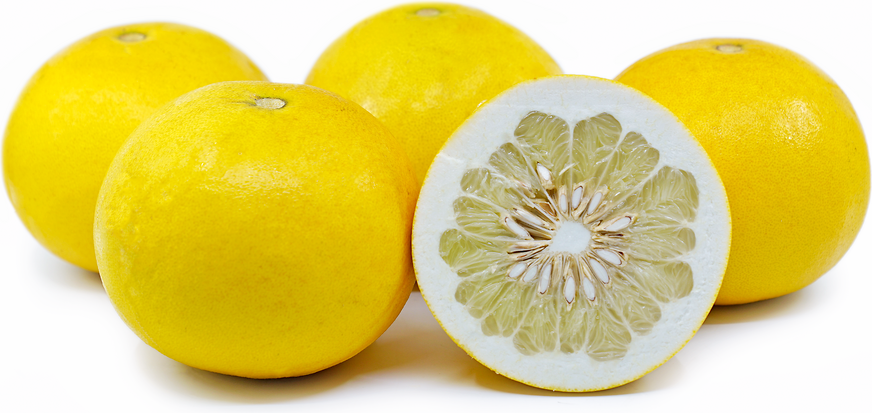


Thong Dee Pomelos
Estimated Inventory, lb : 0
Description/Taste
Thong Dee fruit are large and oblate, with a slight depression at the apex. The rind is light yellow in color, and fairly thin for a pomelo, with a pink tinge on the inside. The white to pink flesh inside is very juicy and easy to separate into sections. Pomelos are mostly sweet, with undertones of acidity. Like many other pomelos, Thong Dee can be seedy if the tree has been pollinated by another citrus, but is seedless otherwise.
Seasons/Availability
The Thong Dee pomelo is available mid-winter through early spring.
Current Facts
Pomelos are a type of very large citrus fruit gaining in popularity in the United States. Thong Dee, or Citrus maxima 'Thong Dee,' is a Thai variety of pomelo; it is also known as Khao Thongdi, or Golden pomelo. Thong Dee's specific parentage is unknown, but came to the mainland United States via Hawaii.
Nutritional Value
All pomelos are excellent sources of Vitamin C— one cup of pomelo flesh provides almost two hundred percent of the needed daily value of Vitamin C. They are low in calories, fat, and most vitamins and minerals, but have some dietary fiber and potassium.
Applications
Pomelos are easy to eat raw and are often squeezed into juice. To prepare, cut the fruit in half and then into slices, or scoop out the flesh with a spoon. Peeling with a knife and dividing into sections is also simple. For more elaborate preparations, the flesh can be made into jam, cut up into salads, baked into desserts, or added at the end of cooking chicken or seafood dishes. The thick skin is inedible as is, but can be candied or made into marmalade. Choose pomelos that are heavy, have unblemished skin, and give off a floral scent. They can be stored for up to two months at room temperature if they are fresh, or in the refrigerator.
Ethnic/Cultural Info
Pomelos occupy a prominent place in some Chinese cultures. In addition to being eaten at the Lunar New Year, pomelos are used in traditional medicine to treat a variety of ailments such as lung disorders, abdominal pains, and coughing.
Geography/History
Pomelos are native to southeast Asian countries such as Malaysia and Fiji and were introduced to China around 100 B.C.E. Legend has it that a sea captain named Shaddock brought pomelos to the Caribbean. Although they spread throughout the Americas, pomelos generally did poorly in North America. However, they were successfully crossed with wild oranges to develop grapefruit. Most pomelos are still grown in Asian countries and other tropical regions, but today are also grown in smaller quantities in California and Florida.
Recipe Ideas
Recipes that include Thong Dee Pomelos. One
| Stirring Stew |
|
Jicama and Pomelo Salad With Spicy Thai Dressing |
| Guai Shu Shu |
|
Mango Sago Pomelo Dessert |
Podcast




